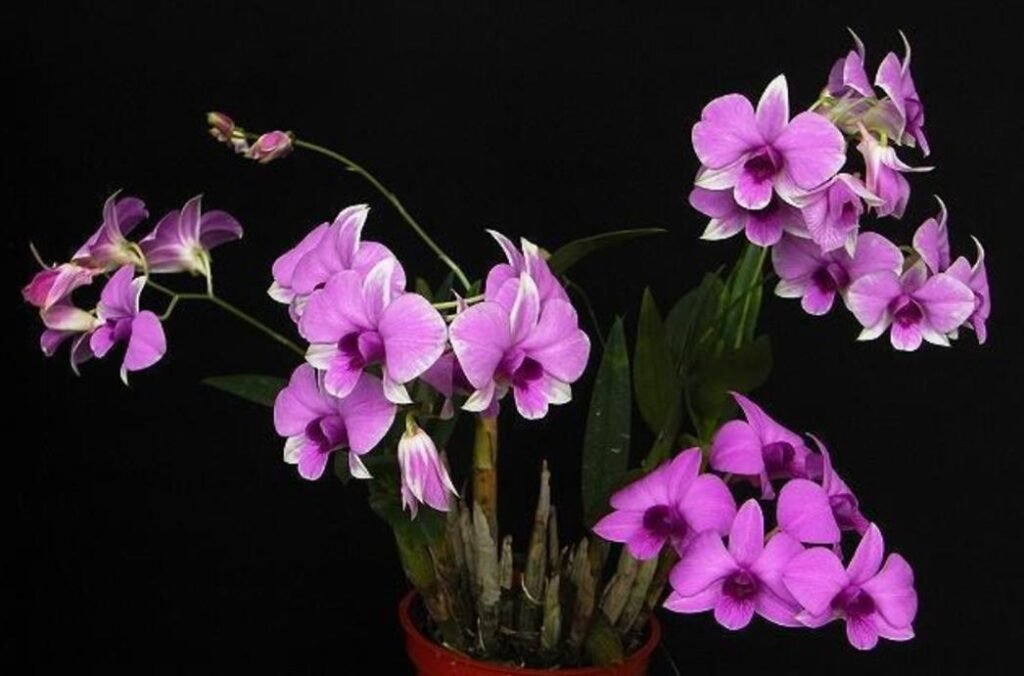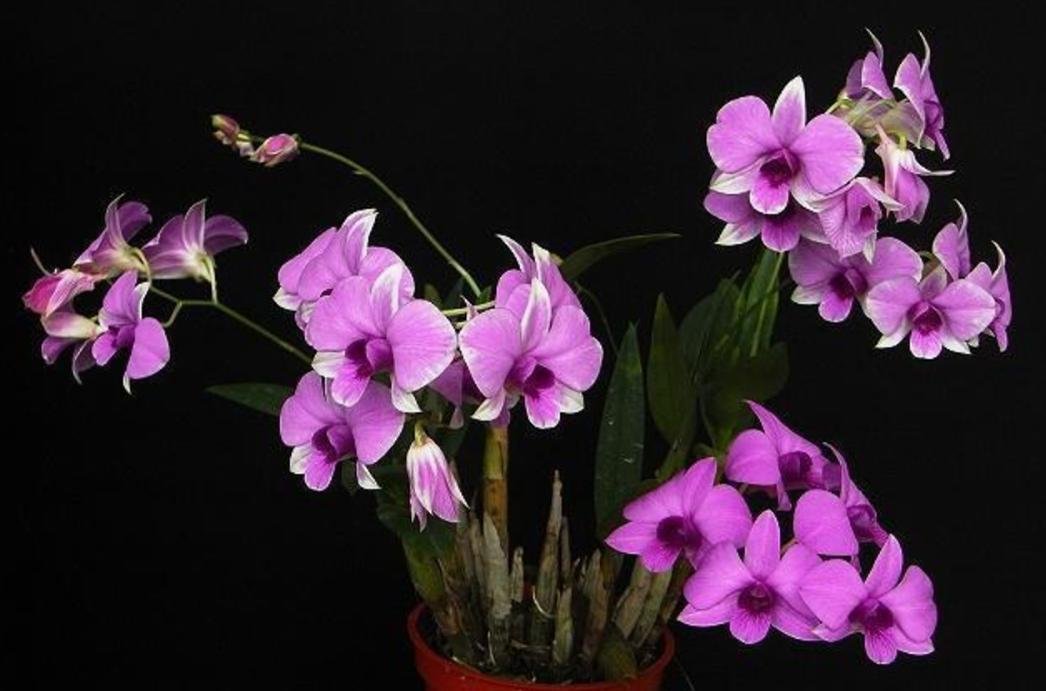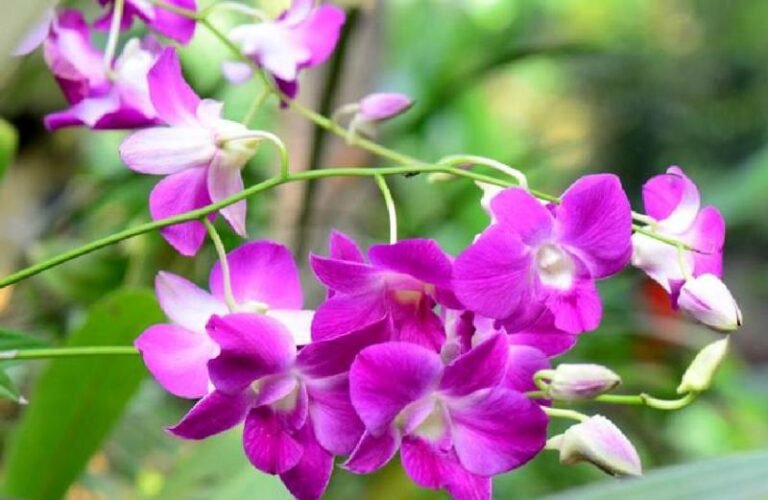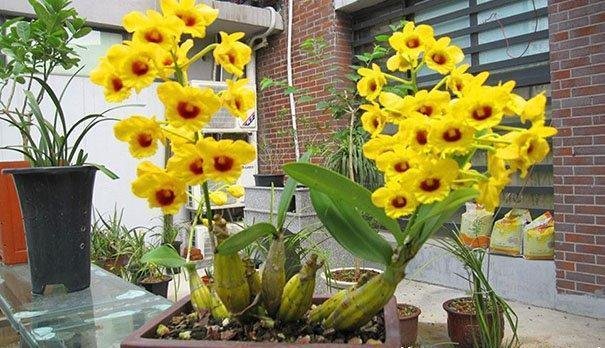Dendrobium hybrida
Autumn Dendrobium is a collective name for autumn-flowering tropical orchids of the genus Dendrobium in the family Orchidaceae, known as the ‘Father’s Flower’.

Autumn Dendrobium is mostly attached to trees or rocks, pseudobulbs are cylindrical, plants are clustered, fleshy and solid, grey leaf sheaths cover the base, leaves are alternate, leaf blade boat-shaped.
Flowering in autumn, the pedicels are drawn from the apical leaf axils, each pedicel bearing from 4 to 18 flowers; sepals three.
The petals are the largest part of the flower, broadly ovoid, rounded at the apex, sometimes slightly convex, while the labellum is entire, obscurely three-lobed, curled at the base to protect the staminal column, and slightly expanded at the apex.
The colour of the flowers varies according to the variety, with intense purplish-red, pure white, white flowers with red lips, purplish-red petals with white edges, white flowers with light purplish edges, deep purplish-red petals with white lips and other colours.
Brief Description:
The flower shape of this strain of Dendrobium autumnum resembles a butterfly, and its species name (phalaenopsis) means butterfly-like, and when in full bloom, it looks like a field butterfly fluttering in the field.
Autumn Dendrobium and phalaenopsis really have some similarities.
Because of the flower shape of Dendrobium autumnum is like a butterfly, some people also call it ‘Dendrobium phalaenopsis’;
There is another kind of autumn dendrobium that is less common in the market, whose petals are slender and curled like antelope horns.
The former is mainly from Hawaii, with large, plump and reddish flowers, and is the most common Dendrobium in Taiwan;
The latter is mostly from Thailand and Hawaii, with large variations in flower shape and colour, and a long and irregular flowering period.
Their pseudobulbs are cylindrical, clustered, up to 60-70cm high, fleshy and solid, the base wrapped by grey and brown leaf sheaths, the upper stem nodes obvious, the upper stem nodes obvious, the upper stem nodes obvious, the upper stem nodes obvious, the upper stem nodes obvious.
The upper stem nodes are obvious, and several pairs of boat-shaped leaves are borne at the upper stem nodes, and the length of the leaves is about 10-18cm.
Flowering stems are drawn from the leaf axils at the top and can be up to 60cm long, with 4 to 18 flowers per stem in a wide range of colours.
The diameter of the flowers is generally about 5-7cm, and the three outermost sepals are the upper sepals, which are elliptic with an obtuse apex, and the lower sepals, which are 2, obtuse at the apex.
The lower sepals are 2, wider or the same as the upper sepals, the apex often has a cusp, the most interesting is its base, often extended backward and form a thing like human chin, in orchid terminology is called ‘chin’ (Mentum).
The petals of Dendrobium autumnum are the largest part of the flower, broadly ovoid, rounded at the apex, and sometimes slightly concave; the labellum is entire, inconspicuously trilobed, and curled at the base to protect the staminal column, with the apex slightly extended.
Ecological habits
Prefer warm, moist. Wide temperature requirements, 8 ℃ can be over winter.
Light-loving, summer need shade. Cultivation substrate is mostly coarse peat, pine bark, vermiculite, perlite, wood chips and other formulations, loose, permeable, breathable. There is a certain degree of drought tolerance.
Cultivation
Propagation
Autumn Dendrobium is propagated mainly by division.
March is the best time to split plants and change pots. When dividing the plants, separate them into 3 stems and cut off the old roots, the new shoots are close to the centre of the pots and planted in fresh medium.
The occurrence of high buds is also a special propagation method for Dendrobium autumnum, which can be cut off and inserted into the water moss to promote rooting, or can be removed and planted after rooting by itself.
In addition, the pseudobulbs can also be cut as scions after removing the leaves, or laid flat on a medium of snakewood chips and moss to propagate new plants.
Fertilisation
During the growth period of young and medium-sized seedlings, apply a balanced fertiliser of nitrogen, phosphorus and potassium, or a fertiliser with a high nitrogen content;
For mature or flowering plants, apply more nitrogen fertiliser in spring to cultivate new shoots and fertilise the pseudobulbs, and in early summer, favour phosphorus and potassium fertiliser, especially phosphorus fertiliser, to promote the enlargement of the pseudobulbs, so that they can store sufficient nutrients for flowering;
At the end of summer and autumn, you can stop fertilising.
In addition to long-lasting fertilisers, it is best to use the principle of ‘applying thin fertiliser more often’, about every 7 to 8 days.
Changing pots and potting soil
Autumn Dendrobium should be changed before it enters the growing period.
Autumn Dendrobium’s root system is slender, more suitable for growing in small pots, if the pot is too large, too much water, easy to make the root system is not fully developed, or even cause the plant to die.
Good drainage is a must for the best pots for cultivation of Dendrobium, so well-ventilated snake wood chips are the ideal potting soil, in addition, add a little moss peat, which helps to maintain moisture.
Cultivation temperature and water
It is suitable to cultivate in high temperature greenhouse, there is obvious dormant period in winter, the overwintering temperature is about 10 ℃, the temperature suddenly rises to 20 ℃ or more will affect the flower bud differentiation.
The appropriate temperature during the growing period is 25~35℃. The temperature should be lowered and watering should be reduced before bud differentiation to facilitate flowering in the following year.
Ensure moisture during the growing period, avoid stagnant water.
Fertiliser requirement is high, and thin fertiliser can be applied once a week during the growing period.


